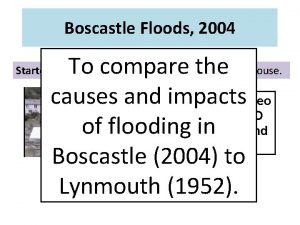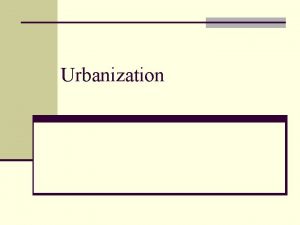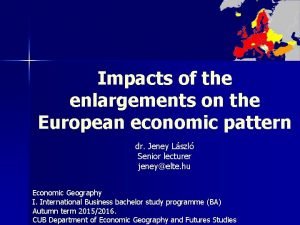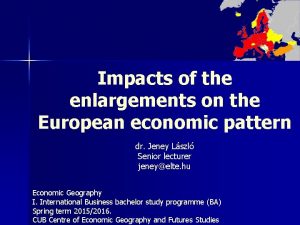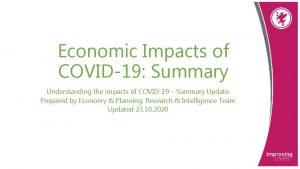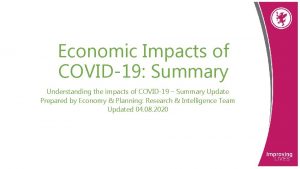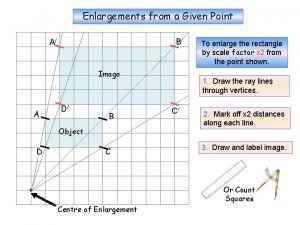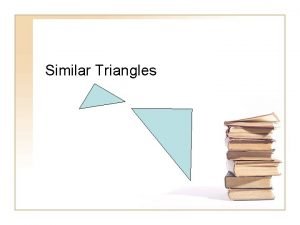Impacts of the enlargements on the European economic
























- Slides: 24

Impacts of the enlargements on the European economic pattern dr. László JENEY associate professor jeney@elte. hu Economic and Human Geography bachelor study programmes (BA) Spring term 2017/2018. CUB Department of Economic Geography and Futures Studies

Insufficient economic dynamism of European Union n GDP growth rate – 1950 s, 1960 s: economic miracles – From 1970 s: slower than USA, Japan + rather fluctuating – After the turn of the new Millennium: GDP growth: 2, 8% n 1960 s: Mass of guest workers – From N Afr. , TR, former YU, later from the other post-socialist countries too) – cultural and legal hampers of their integration n Significant regional differences (per capita GDP, GDP growth) – East accession countries: lagging economy new challenges

The European Core Area n Pentagon/Core – Area: 20% – Population: 40% – GDP: 50%

Geographic shift of the economic core n From Blue Banana (traditional core) to Golden Banana (European Sunbelt)

Geographic concentration of the economy still remained in the Core Economic development: GDP per capita Economic density: GDP per area

Key Factors of Urban Competitiveness in European Space Structure 6

The subject of research, basic assumptions n New factors affecting the regional processes of East Central Europe at the turn of the millennium 1. Transition (the end of the bipolar world system) 2. Integration (accession to the European Union) 3. Globalization n n Dynamic take-off, but cities and rural regions get different developmental impulses Dual effects on economic pattern of V 4 Countries (trade-off theories) 1. Convergence in pan-European relation (catching-up) 2. Divergence in urban–rural relation

Database used and the territorial frame n Economic development measured only with per capita GDP – At current market prices in € – Examined period: 1995– 2013 n 1. Data source: Eurostat http: //epp. eurostat. ec. europa. eu/ East Central Europe – Broader – Cultural, historical relationships 2. V 4 Countries – Narrower – Current political states (CZ, HU, PL, SK) n Regional level: NUTS 3

Definition of the Concept of Urban and Rural Regions n Urban regions = cities – Population >500 thousand + Bratislava – Without suburbs – Regions at NUTS 3 level (Bratislava Bratislavský County) n Rural regions = complementary regions – ≠ Villages – ≠ Regions with rural characters (e. g. sparse population, importance of agriculture)

Cities as positive residuums of the East Central European space structure V 4 (NUTS 3) EU (NUTS 3) USA (SMA) Canada (CMA) population 2004 (million) GDP 2004 (billion €) per capita GDP 2013 (€ per capita) GDP growth 1995– 2013 (%) Total 64 407 6377 206 Cities 8 106 13368 237 12% 26% 210% +31%-point 20% 29% 141% +8%-point 38% 49% 129% 45% 54% 120% Relative state of cities Measuring Urban–Rural Duality DUR = x. U/x. R: =urban–rural duality index x. U: average per capita GDP of cities in a country x. R: average per capita GDP of rural regions in a country

Post-socialist countries characterized with growing urban–rural dualism n Change of Urban–Rural Duality in EU Member States, 1995– 2013 n Differences of Urban–Rural Duality in Member States of EU, 2013 – Chiefly the outstanding of capitals – More remarkable in case of underdeveloped, catching-up V 4 countries than older members Source of data: EUROSTAT

Relationship Between State of Development and Urban–Rural Duality for EU Members, 2013 Source of data: EUROSTAT

Growing Importance of Cities in European Economic Pattern n Most of the cities over average – Studying success of cities: key issue for current European regional trends and regional policy n Some countries – Only the cities are over average (e. g. V 4) – Other inequality factors are more important (Germany, Italy, Romania, Spain) State of cities and rural regions as compared to the national averages of the countries, 2013

Post-socialist cities are to join to the 2 nd level of European city-network n n Studying success of cities: key issue for current European regional trends and regional policy New European models on Peripheries should adjust the classic urban zone of Blue Banana – Sunbelt or (Golden Banana) – Central European Boomerang n Post-socialist cities: new development wave (similar to Southern Periphery) based chiefly on international investments

Cities and NUTS 2 regions: gerrymandering for development n Budapest, Warsaw – Suburban zone lower common average – Initially: better position for EU-supports – Later: due to the urban development no supports n Prague – Suburban zone: target area of EU supports

BUT: weak position of V 4 cities in the European Urban hierarchy n Worse position of V 4: – V 4 countries: 508 company from the 15 thousand largest company of EU – Air traffic n Relative better position of V 4 – International meetings (better position)

The sectorial background of the urban –rural economic development inequalities dr. László JENEY associate professor jeney@elte. hu Economic and Human Geography bachelor study programmes (BA) Spring term 2017/2018. CUB Department of Economic Geography and Futures Studies

V 4: success of cities not independent of the shift of their sectoral structure n V 4: success of cities not independent of the shift of their sectoral structure – Increase of urban–rural inequality is mainly tertiary based – Industrial renewal hide in the background of fine differences among rural regions Agriculture Industry Services Cities 1995– 2013. 1. 3 1. 8 2. 6 Rural regions 1995– 2013. 1. 3 1. 9 2. 1 Growth Indexes of Gross Value Added (GVA) in the Sectors in V 4 Countries, 1995– 2013.

Regional and Sectoral Shifts within Industry after Transition (1992– 1998): The Case of Hungary 19

Regional Shifts in Hungarian Industry, 1992– 1998. 1992 1998 Employment: 995 790 750 900 BUDAPEST (%) 29 22 Industrial output 23 524 33 316 BUDAPEST (%) 36 24 Industrial export 5 449 16 371 FEJÉR county (%) 7 22 BUDAPEST (%) 38 17 20

Sectoral Shifts in Hungarian Industry, 1992– 1998. Industries 1992 1998 Em p l o y m e n t Ou tp u t Ex p o r t Machinery and equipment (%) 21 25 Textile. wearing apparel. leather products (%) 15 17 Food. beverages and tobacco products (%) 18 16 Machinery and equipment (%) 13 36 Food. beverages and tobacco products (%) 23 17 Chemical industry (%) 19 15 Electricity. gas. steam and water supply (%) 20 12 Machinery and equipment (%) 27 61 Chemical industry (%) 25 Food. beverages and tobacco products (%) 18 21 12 8

Changes in Regional Industrial Specialization in Hungary, 1992– 1998. Hirschman–Herfindahl index n 1992 1998 employment output export 22

Regional Differences of the Economic Development Level in Hungary, 1998. (NUTS 3) 23

Conclusions 1. Postsocialist countries: characterized with growing urban–rural dualism – – – 2. Chiefly the outstanding of capitals More remarkable in case of underdeveloped, catching-up V 4 countries than older members Not only the urban–rural inequality increases, but its role is more and more appreciated in overall regional inequalities V 4: success of cities not independent of the shift of their sectoral structure – – Increase of urban–rural inequality is mainly tertiary based Industrial renewal hide in the background of fine differences among rural regions 24
 Negative and fractional enlargements
Negative and fractional enlargements Innervations of the brachial and lumbar enlargements
Innervations of the brachial and lumbar enlargements Benefits of logging in solomon islands
Benefits of logging in solomon islands European exploration economic reasons
European exploration economic reasons Difference between economic growth and economic development
Difference between economic growth and economic development Economic systems lesson 2 our economic choices
Economic systems lesson 2 our economic choices Economic growth vs economic development
Economic growth vs economic development Putting-out system
Putting-out system Causes of the boscastle flood
Causes of the boscastle flood Disadvantages of commercialization of sports
Disadvantages of commercialization of sports Positive impacts of tourism in glasgow
Positive impacts of tourism in glasgow Impacts of imperialism
Impacts of imperialism Pardoner's tale irony
Pardoner's tale irony Positive impacts of information technology
Positive impacts of information technology Cosmomagical cities
Cosmomagical cities Long term impacts of the industrial revolution
Long term impacts of the industrial revolution How did the gaa impact irish life
How did the gaa impact irish life Impacts of climate change
Impacts of climate change Positive effects of ww1 on canada
Positive effects of ww1 on canada Luqman long
Luqman long Lasting impacts of the new deal
Lasting impacts of the new deal Socio-cultural impacts
Socio-cultural impacts Social impacts of information technology
Social impacts of information technology Ecotourism advantages
Ecotourism advantages Major rishi nair
Major rishi nair








